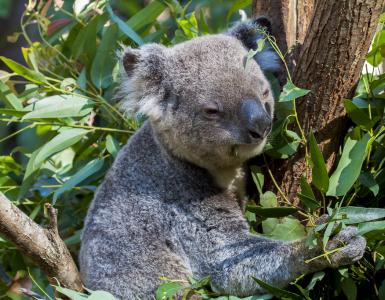Like a koala hugs. Scientists have explained why koalas hug trees. Whims that hit your pocket
Last Wednesday we did go to Currumbin Zoo on the Gold Coast.
This is our second visit there and this time I liked the zoo more, which is easily explained by the smaller number of people eager to get a glimpse of real Australian animals. As a supporter of getting to know the local fauna in its natural habitat, I am not a big fan of zoos, but I must say that Currumbin Zoo creates a pleasant impression and gives a fairly complete picture of the wild inhabitants of the Green Continent.
Among all Australian animals, the most controversial for me is the koala.
I’ll explain why... A seemingly cute, cozy and eternally sleeping bear, in reality it turns out to be an evil, smelly, clawed drug addict, screaming like crazy at night, with wiry fur and an expressionless look.

It is not for nothing that in Australia there is a “belief” about the presence in the forests of the so-called “drop bear”, due to the presence of which it is strictly not recommended to put up tents under trees. Old-timers say that at night this creature jumps from above the tent, tears it to shreds with its powerful claws and kills its inhabitants. You can escape the attack by stuffing forks in your hair, smearing Vegemite or toothpaste on your ears, and conducting conversations in the intended habitat exclusively in English with an exaggerated Australian accent. 8))) By the way, in the Australian Museum in Sydney an entire section 8))) is dedicated to this mysterious beast
Jokes aside, the koala is really not such a cute little animal. If you meet him, he won’t kill you, but he will make you hold your nose. The fact is that they are unhurried animals, since their existence is “poisoned” by toxins contained in eucalyptus leaves.

Being constantly “high”, they lead a “immovable” lifestyle, especially in zoos, where food comes on its own, devoting 20 hours a day to sleep. Accordingly, the smell from feces is still around.
As for the “plushness” of koalas, if you pick them up, you find that their fur is hard and their claws are very sharp... The eyes of koalas have vertical pupils, which produces a strange and even, I would say, repulsive impression.

The devilish nature also manifests itself in behavior. People say that if you behave badly in this life, then in the next you will be born a female koala, which is brutally raped by the males during the breeding season.
While traveling around Australia, we spent the night several times in forests where koalas live. One night a roar was heard in the forest. If you are not aware of your position in space, then you might think that a pride of lions is grazing next to the tent... It was scary 8))) In the morning we were told that it was a male “teddy bear” growling.
Of course, like all animals, the baby koalas are very cute 8))) This time we had the pleasure of watching several “bears” “scurrying around” in the enclosure.

The koala is a herbivorous marsupial animal, it belongs to the koala family, the order of two-incisors. Koalas are mammals, they look like cubs in appearance, so Australian settlers called this animal the koala bear or sac bear. This name is still used today, although these animals have nothing in common with a bear.
The body length of the koala ranges from 60 to 80 cm, its weight is 5 - 15 kg. (depending on climate). The animals have a large round head and fluffy ears. They have rather long paws with tenacious claws. There is a papillary pattern on the koala's fingertips, its prints are similar to human ones. These “cubs” have thick gray or gray-brown fur and a lighter belly. Koalas do not have a tail. The paws of animals with fingers set to the side and sharp claws are perfectly adapted for climbing trees. The animals sleep on the tree and can hold onto the branches even with one paw.
The female koala has a pouch on her belly for her baby. These animals breed once every two years. There are more females than males, so during the mating season the male has a harem of 3-5 females. A newborn animal climbs into its mother’s pouch, where it is warm and has milk.


Koalas are nocturnal animals and live in trees. Calm and slow bears can sleep up to 20 hours during the day. But these animals can climb trees well, swim and deftly jump from tree to tree. In case of danger, the koala can gallop and quickly climb a tree.




Beautiful photos of the marsupial animal - koala:
Koalas live in eucalyptus forests, the leaves of which are eaten. These animals have adapted to feed exclusively on eucalyptus. It is fibrous and contains a lot of protein. But the disadvantage of this plant is that eucalyptus contains phenolic and terpene compounds that are poisonous to most animals. Besides koalas, the only animals that eat eucalyptus are the ring-tailed glider and the marsupial flying squirrel. There are many types of eucalyptus growing in Australia, but koalas only choose the edible ones. The animal eats up to one kilogram of leaves per day. Koalas do not drink water; they get it from eucalyptus leaves.
Local predators do not eat koalas, as their meat is soaked in eucalyptus. They can only be threatened by wild dogs. But slow and trusting koala bears have become easy prey for hunters. They were killed to obtain the thick, valuable fur of these animals. Koalas were also threatened by deforestation of eucalyptus forests and forest fires. All this led to a reduction in the number of animals. The Australian government has banned koala hunting and opened koala reserves. Now their population is gradually recovering thanks to free living in their natural habitat.
Video: Koala: what do we know about Marsupials?
Video: Koala Helps Her Frightened Baby
06/04/2014 at 16:47, views: 16606
This question was of interest to the Russian traveler Nikolai Mikhlukho-Maclay (1846-1888). Scientists have found that koalas, hanging on trees for hours, use tree trunks as refrigerators. Australian researchers from the University of Melbourne came to this conclusion. Observations also showed that in the heat, koalas prefer to hang on acacia trees rather than eucalyptus trees.
Photo: S.Griffiths/Biology Letters.
During intense heat, animals descended to the lower part of the tree, where the trunk and branches were the coldest, and pressed their whole bodies against them. Gradually, the koalas' body temperature dropped.
The study was published in the Royal Society journal Biology Letters. Scientists from the University of Melbourne used thermal imaging cameras to capture images of koalas descending to cooler parts of a tree in hot weather.
For example, when the air temperature reached 39 degrees, the temperature of the tree trunk was at least seven degrees lower.
“This got us thinking that koalas might be using trees as a heat sink,” said University of Melbourne professor Michael Kearney.
A similar observation was made by graduate student Natalie Brusco, who studied the behavior of koalas. In winter, animals are more likely to sit in the treetops near the leaves they eat, she said. In summer, koalas descend lower.
The koala (Phascolarctos cinereus) is a tree-walking herbivorous marsupial native to Australia. The only representative of the Koala family. They live in coastal areas in eastern and southern Australia, from Adelaide to the southern part of Cape York Peninsula, as well as on Kangaroo Island, where they were introduced in the early 20th century. They are also common in regions with enough moisture to support forests suitable for koalas. South Australia's koalas were largely wiped out during the first half of the 20th century, but with the help of individuals from Victoria, the koala population in South Australia has been restored.
Although koalas are not bears, they were called koala bears by English-speaking settlers of the late 18th century due to the similarity between koalas and bears. Although taxonomically incorrect, the name "koala bear" is still used outside Australia, but its use is discouraged due to inaccuracy in the name. Other names for this animal in English based on the word "bear" were "bear-monkey", "native bear" and "tree bear".
So, you have learned to love and accept your child for who he is, that is, accept him without any conditions or evaluations. Figuratively speaking, having stood on the first step of the ascent to mutual understanding, you simply took his hand.













